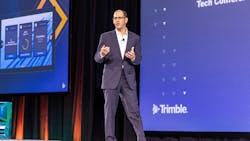Trimble boosts focus on connecting data to find fleet cost savings
LAS VEGAS—The world is more connected than ever before. But more data is also being created than at any point in history. In the trucking industry, fleets have so much data to work with some could be confused for technology companies.
The world produces more than 2.5 quintillion bytes of data daily, Trimble chief executive Rob Painter told hundreds of customers gathered here at the Venetian Convention & Expo Center for Trimble Insight 2023. The pace and power of computing, he noted, is only getting more robust and complicated.
“Over 90% of the world’s data has been created in just the last couple of years,” Painter said during his opening remarks. “Most of this has been enabled by the convergence of technology at the intersection of connectivity, compute power, and cloud. Our innovation efforts at Trimble build on these trends.”
Connected data is a cornerstone of Trimble’s Connect & Scale strategy, which aims to link users, data, and workflows across the transportation industry lifecycle: from procurement to planning to execution. Painter said it is a customer-centric strategy that puts users and customers at the center of everything Trimble does.
Ron Bisio, SVP of Trimble Transportation, has spent his first year leading the division, traveling the country to visit fleet customers and see how data works within their operations.
“I was in a meeting in New Jersey, and somebody said, ‘You chose a great time to join transportation—it has never been this bad. Help us find a half-cent per mile [in savings],’” he recalled during his opening address. “That's what we're working toward helping you find.”
Data dilemma and connections
During a roundtable discussion with industry journalists, Painter acknowledged that with all the data out there, it can be complicated for fleets to figure out where to start. “I’m a believer in starting by asking the ‘why?’ As in what problem are you trying to solve? What opportunity are you trying to create? I think, in the absence of that, you can sort of be without a rudder to know which direction you’re sailing.”
He suggested that fleets start with that self-assessment by looking at their profits and losses, looking through their customers’ perspectives, or judging how their fleet compares to the rest of the industry.
“We tend to ask companies [what their vision is and where they are going] as well. So it’s not just about what problems you are trying to solve. It’s ‘Where are you going?’ I think by starting there—and by starting with the vision they are trying to achieve. We grew up in Trimble by thinking about working backward from the endgame.”
Bisio used the example of meeting customer requests to create seamless data driver experiences between the cab and the back office. “That was a great example of what we can do when the customer told us what they wanted.”
That ties back to finding small savings that can solve big problems. “I was sitting there with one of our key customers who was just saying, ‘Well, how do we find that half a cent [per mile]?’” Bisio recalled during the media roundtable. “Whether it be in maintenance, better use of our fuel solutions, or even improving driver experience in not having to do retraining or keeping the driver churn down. All those kinds of things can help them save that half cent.”
Benefits of connected data
Trimble's Connected Fleet solution connects data from vehicles, telematics, and other sources to give customers real-time visibility into their fleet operations. This data can be used to optimize routes, improve fuel efficiency, and reduce costs.
Connected data offers several benefits to fleets of all sizes, according to Trimble:
Improved visibility: Connected data can help businesses gain a more holistic view of their operations and identify areas where they can improve.
Better decision-making: Connected data can help businesses make better decisions by giving them the information they need to understand the root cause of problems and identify the best solutions.
Increased efficiency: Connected data can help businesses automate tasks and streamline processes, increasing efficiency and productivity.
Reduced costs: Connected data can help businesses identify and reduce waste, leading to lower costs.
Improved customer service: Connected data can help businesses better understand their customers' needs and provide them with the products and services they want.
About the Author
Josh Fisher
Editor-in-Chief
Editor-in-Chief Josh Fisher has been with FleetOwner since 2017. He covers everything from modern fleet management to operational efficiency, artificial intelligence, autonomous trucking, alternative fuels and powertrains, regulations, and emerging transportation technology. Based in Maryland, he writes the Lane Shift Ahead column about the changing North American transportation landscape.



